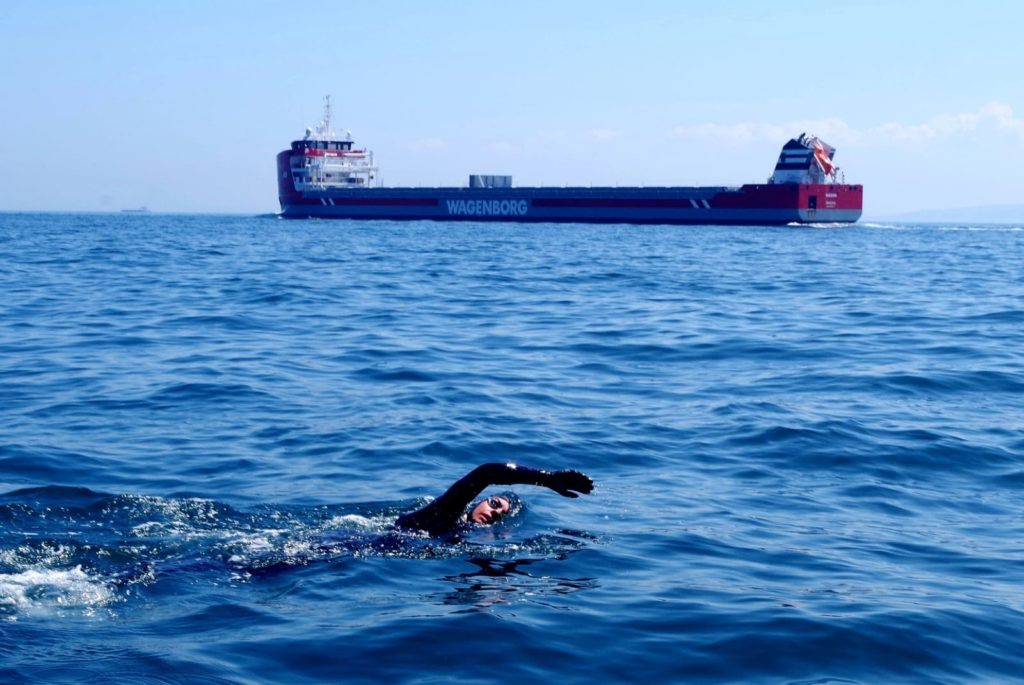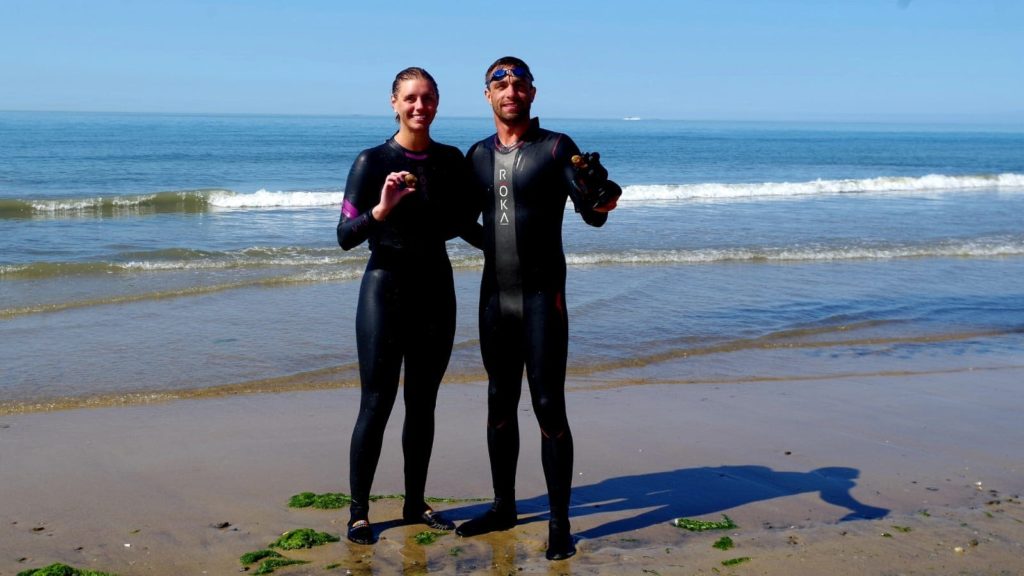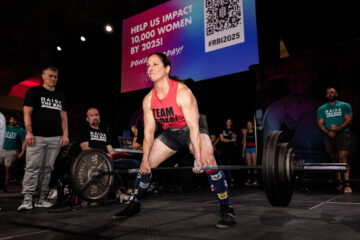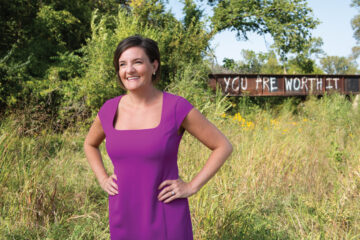By Emily Barske, Business Record editor

When I told friends and colleagues that my sister – Elizabeth (Barske) McLain – was going to swim the English Channel, a lot of them responded with disbelief or awe. But I, for one, wasn’t shocked.
For as long as I can remember, my sister has been a swimmer. Elizabeth, who’s 2½ years older than me, had already set a precedent for our family name by the time I was in swim lessons as a 4-year-old. She already had an impressive collection of ribbons from the Blue Wave swim team at the YMCA before I dove in for my very first race. And when it came time for me to join the high school swim team, Barske was already a recognizable name on a Marshalltown High School swim cap – and spectators could tell they were about to see a good race, thanks to her.
Not only is she a lifelong swimmer, but she’s pretty stubborn. (Maybe she’d choose a different word, but this is my column.) That’s why when we were on a trip in Athens, Greece, we kept climbing up a mountain to see the Parthenon despite my inquiring about whether we were on the right track since no one else seemed to be going up this trail that supposedly led to one of the most famous ancient ruins and tourist destinations in the world. It turns out we were indeed on the wrong mountain, though we still eventually made it there. But the moral of the story is: If she says she’s going to do something, come hell or high water – there’s literally high water in some cases – she’s going to do it.
Those intending to make the swim across the English Channel are given a two-week time period where they must stay in the area so that they are available to swim as soon as crews deem the currents and weather safe for swimming. Due to the coronavirus pandemic, they also had to quarantine when they got there. So on June 16, Elizabeth and her friend David Perales got a call before they went to sleep that they were to start their swim across the English Channel at 2:30 a.m. from Samphire Hoe beach, just southwest of Dover, England.
Their boat crew took them out to the starting point. While the straight line on a map from the start in England to the end in France is 21 miles, each person or team that swims the English Channel will have a different total distance because of the open water currents.
David took off from the beach and swam the first leg. “And he made it look really easy,” Elizabeth said, to which David responded, laughing: “That was the goal.”
Elizabeth said the first couple of legs were the hardest for her because of swimming in the dark without a clearly visible guidepoint and not being able to see the waves coming at you. They each had to wear lights on them so they could be seen in the dark. For David, the hardest part was later in the swim when his shoulder locked up and he had to take ibuprofen.
Each of them swam for an hour at a time while the other looked on with the crew in the guide boat. To sustain their energy, they ate high-sugar foods like jelly sandwiches, had a parka to warm themselves up in, and even took a couple of naps between swims.
For a swim to be officially sanctioned by the English Channel Association, you are only allowed to wear one swimming garment and can’t wear a thermal swim cap. Often swimmers doing that will put porpoise fat or grease on themselves to keep warm. Elizabeth and David opted to wear wetsuits, so it wasn’t an “official” swim. (That sounds much more appealing than porpoise fat, if you ask me.)
Both of them said that while they were swimming they were thinking the swim was easier than they had made it out to be in their heads. They had properly trained, and part of what made it scarier beforehand was the unknown. They knew how cold it would be and how far they’d have to go, but they didn’t know many of the little details about what they’d encounter or how it would feel. Once they got into a rhythm, their training took them through.
That’s not to say nothing unexpected happened. They both at one point got startled by seaweed that touched their hands or their faces. When they read the observer’s notes and statistics after the swim, there was a note that said, “8:45: Dave stopped swimming, head up and looking around – startled by weed! Quickly swimming again.”
But the actual task at hand wasn’t that scary to them, although Elizabeth kept thinking, “Dear God, please don’t let me get stung by a jellyfish.” (If you’re wondering if there are sharks in the English Channel – my mom certainly was – the English Channel Association says in its FAQ section, “It is too cold for most sharks … and sightings are so rare that you won’t need a cage!” If that makes you feel any better.)
While giving safety instructions ahead of the swim, the guide told them in his 20-plus years of doing this, he’d never had to alert swimmers of lobster cages ahead, but he had to warn them about it anyway. So naturally, at one point while Elizabeth was swimming, a lobster cage hooked to a buoy came up on the left side of the boat, out of her sight since she was on the right-hand side, and the guide blew a horn at her to swim in while the buoy whizzed by her.
In 13 hours and 28 minutes, they completed the 31-mile swim and landed in Wissant, France, a little after 4 p.m.
A few hundred people complete the journey every year nowadays. Yet only a few thousand out of Earth’s billions have made the swim since it was first completed by Matthew Webb in 1875. Sixty-three percent of swimmers have been male and only 37% have been female, according to the city of Dover’s website.
The Channel Swimming Association was established in 1927 to officially sanction the swim and put in place a set of rules for those completing it individually or as a relay, like Elizabeth and David.

Diving in
Elizabeth said the swim had been on her bucket list for years – for no profound reason other than she’d always been a swimmer and it seemed like a big accomplishment to aim for. David had written it on a bucket list for a project during his senior year in high school after looking up some of the top items other people put on their bucket lists.
The bucket-list item became more feasible for Elizabeth when she moved to Europe. She and my brother-in-law, Zack, who is a staff sergeant in his explosive ordnance disposal unit in the U.S. Army, have been stationed in Germany for a little more than three years. They had previously been stationed at Fort Hood, Texas, where Elizabeth met David at the pool – and coincidentally, so did I when my sister took me swimming during one of my visits to see her.
David is a runner, and did not grow up a swimmer. My sister, the exact opposite – we swimmers didn’t particularly care for on-land exercise growing up. But after college, she grew to love triathlons and trained for all kinds of races.
While swimming laps at Fort Hood, David asked my sister for some pointers on swimming since he was getting back into training for triathlons after not being able to while stationed in Italy. Both of them compete in many endurance races, especially triathlons.
David, who is a chief warrant officer two in the Army, was also sent to Germany after his station in Fort Hood. When Elizabeth mentioned that she wanted to swim the English Channel, he first said, “You’re crazy – but can I get in on this?”
“I was upset at first because I thought I wanted to do it by myself – and then I found out the water was usually under 55 degrees. And then I was like, oh yeah, we’re doing this as a team,” Elizabeth said.
I made sure to fact-check this version of events with David because, at least in my experience, Elizabeth has a habit of roping people into things she wants to do (*cough cough* climbing the wrong mountain in Greece).
But in this case it seems she wasn’t stretching the truth.
“It was on my list to-do, but I would never do it by myself. How far I have come since swimming with you two at Fort Hood,” David said, laughing.
The two intended to do the swim in the summer of 2020, but the coronavirus pandemic put the kibosh on that and despite having started training, they had to put off the swim until 2021.
Still, finding pools that were open during COVID shutdowns in Germany wasn’t that much easier at the beginning of this year.
David was able to start swimming again at military facilities in December 2020, but at the time only military members were allowed, and not their family members. So Elizabeth wasn’t able to start training again until March – though both of them did plenty of other exercise throughout the pandemic. David also had to do fieldwork during May, which meant he couldn’t swim for a few weeks. But one way or another, they found the time and space to get in the training they needed, typically swimming 3,000 to 4,000 meters in the pool or for about an hour when they did open-water swims.
Take the risk
I just finished reading “Why We Swim” by Bonnie Tsui, and she talked about the power of envisioning your swims before a race, a strategy used by Olympic greats like Katie Ledecky and Michael Phelps. Tsui wrote that during this process of running through a race in your head, losing was never an option for Ledecky or Phelps. They always won in their heads, and they almost always won in real life, too.
Many say that swimming is as much about mental strength as it is about physical strength. So I was curious whether doubt about not being able to make the entire swim came across Elizabeth’s or David’s minds while they were training.
“I felt pretty confident about it because I’ve always been a swimmer and to have somebody else that’s really good at swimming there swimming with me. The only scenario that I thought that maybe we might not make it is if we had bad weather,” Elizabeth said. “I thought we would make it one way or another.”
David said he was afraid of not being able to complete the swim, especially with how much he knew it meant to Elizabeth, when I asked him what his biggest fear was going into the swim. While the two have done plenty of other grueling races, the English Channel was bigger. “It’s not just a physical challenge, but there’s a lot of coordination that has to go into it,” he said.
To train for the swim, it’s recommended you do cold water swims or even take cold showers so that your body gets used to being cold. You have to learn to eat every hour so that you can sustain your energy for that long of a swim.
So while Elizabeth was confident they’d make it, her biggest fear was “getting stung in the face by jellyfish, or getting eaten by another sea critter of which I could not see below me.” But taking risks requires you to work toward your goals, even if you’re afraid of the circumstances or outcome.
When they got in the boat for the swim, the crew members started talking about how the swim is almost never just 21 miles because of the currents. Even though that was daunting to hear, Elizabeth said that you have to take things one step at a time.
“Don’t be afraid to take risks … because one way or another, everything’s going to pan out in the end,” Elizabeth said. “As long as you’re being smart about it and not taking life-threatening risks. Definitely train before you go swim the English Channel. Don’t just try and go do it – that’s a bad risk.”
And if taking a risk seems too daunting, then “accept the risk is beyond your comfort zone and find someone to share the burden with,” David said.
Elizabeth coaches swimming, and I wondered what she hoped her swimmers would take away from her accomplishment.
“It sounds cliche, but I hope that they take away that anything is possible if you set your mind to it. They really can do anything they want to.”


1 Comment
Kurt Dickson · July 14, 2021 at 2:31 pm
Meh. Did it solo over 3 hours faster, without a wetsuit (according to marathon swimming rules, wetsuit doesn’t count).
Comments are closed.